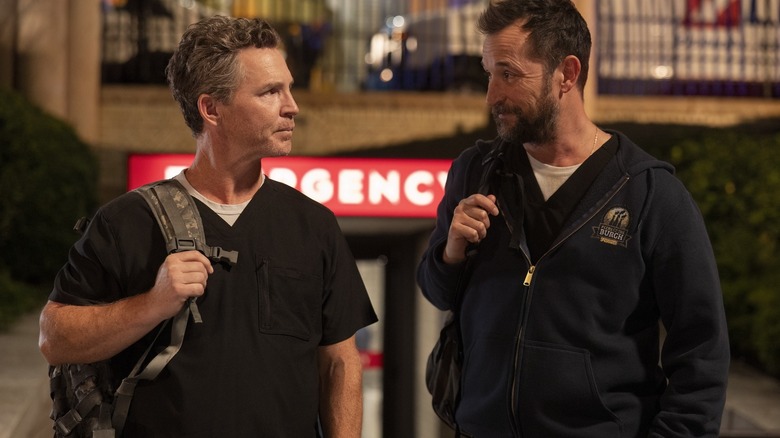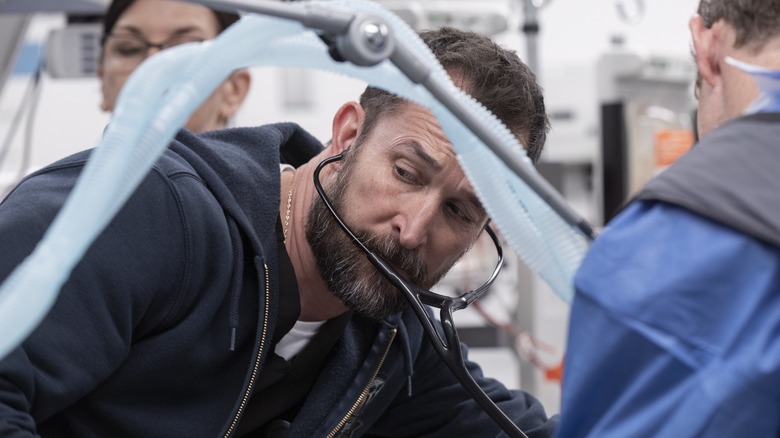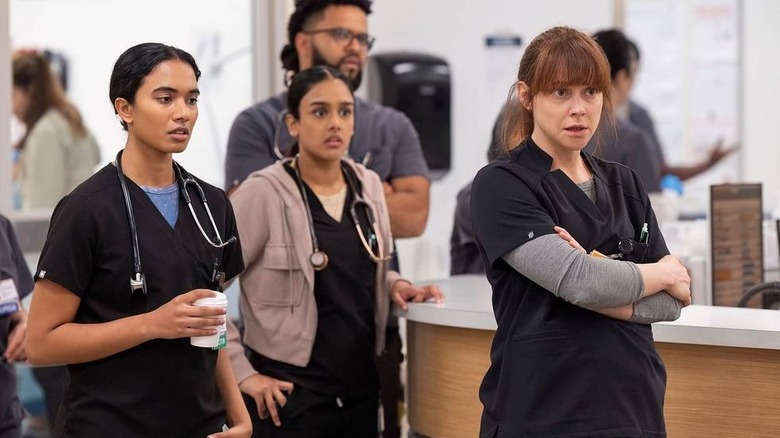The Real Reason The Pitt Takes Place Over A Single, 15-Hour Shift
The thing that sets HBO Max's hit original series "The Pitt" apart from other medical shows — including "ER," a show that paved the way for "The Pitt" in many ways but did not inspire it as a spin-off, for legal reasons — is its unique narrative structure. Throughout the first season, which began in January 2025 and concluded in April, we follow attending trauma physician Dr. Michael "Robby" Robinavitch (Noah Wyle, who helped create the series and works as an executive producer) through a 15-hour shift at a crowded emergency room in Pittsburgh. Each episode takes place "in real time," with the season beginning at 7:00 A.M. and ending at 10:00 P.M. So why did Wyle, executive producer and director John Wells, and showrunner R. Scott Gemmill, who all worked together on "ER," come up with this exact conceit?
"We've sort of done ... sort of done the mack daddy of all medical shows," Gemmill said during an episode of Emily Silverman's podcast "The Nocturnists" alongside his collaborator Joe Sachs (who worked on "ER" and is also part of "The Pitt") and Mel Herbert, the founder of EM:RAP, which helps support medical education specifically for emergency rooms.
"So when the opportunity came about to revisit doing another medical show, one that we wanted to make completely different, it was looking at, how can we tell these stories differently than we have in the past?" Gemmill continued. "And once it became a streamer, because it was HBO Max who was asking for it, we knew already it was going to be different in terms of what you can show language, but also in terms of how many episodes you do." He went on:
"So we're looking at shows that are now [six to eight episodes, 10 to 12 episodes] is maybe the most, and if we weren't on streaming, I don't know if I would have come up with that idea, but it was because it was 12 episodes, and the shift is 12 hours, it seemed like a really logical fit. And the more we thought about it, even though it seemed pretty daunting task at first, the one thing that really I think, differentiates the emergency department from other forms of medical practice is the time element. People come to the emergency department, sometimes through ambulance service, where time is of the essence."
The real wait times in emergency rooms helped inspire the framework of The Pitt
In the end, R. Scott Gemmill says that the concept of time was huge for "The Pitt," because things take a while in a real emergency room; throughout season 1 of the show, we watch the same patients receive treatment across multiple episodes and also see people throwing fits in the waiting room because they haven't been seen yet. As Gemmill put it, this is a phenomenal way to ensure that the show remains as authentic as possible.
"So time just seemed to become such an important part of the whole process," Gemmill said. "One of the things with ER physicians, and these guys can speak to it much better than I can, but is how often they're pulled away to another situation, another case, someone else needs them that every three to five minutes they're on something else. So that became really important, as we talked earlier about the authenticity. And so rather than following a patient through the course of one episode, and they come in and we fix them up, and by the end, they're better. Everyone who's been to the emergency department knows your wait alone is going to get you through four or five episodes, and we really wanted to capture that. And so the time element became a really big part of it."
Gemmill said that this presented some understandable challenges — one can imagine that, you know, the cast had to look as if it was only one day despite time passing during filming — but it all paid off handsomely. "And as challenging as it was, and we weren't sure it was going to work, I think it really elevates the show," he concluded. "It's very hard to capture that feeling of the emergency department, because it's so alive and it's so electric, and there's so much going on. And seemed like if we took the audience into that environment and didn't let them out, we're not going to commercial breaks. We're not coming back two hours later."
"We don't go into their private lives at all," host Emily Silverman pointed out. "No, and so it's kind of like Robby not being able to find time to use the restroom. The audience doesn't get a chance to step away. They're sort of juggling the cases the same way the doctors are, and I think that really helps pull you into the storytelling, because you can't leave until that hour or that shift is over." Silverman is right; it makes "The Pitt" particularly gripping to watch it unfold in "real time."
A writer on The Pitt says the real-time concept helps continuity and throughlines
Joe Sachs, who works as a co-executive producer and penned multiple episodes of season 1 of "The Pitt," then weighed in and said that the "real time" element helps create tension throughout the show. "The other thing that real time allows us to do is to keep the audience guessing," Sachs revealed. "When you meet a patient, is this patient going to be one-and-done [in] one episode? Is it going to evolve into something that's going to last for four episodes or eight episodes or 15 episodes? It's just the mix of everything going on, and having to pay attention to what's going on. And the astute viewers might look in the waiting room in episode one or two and see somebody sitting there who becomes a major character at hour four or five, that we would just actually pay the actors to sit in the waiting room for one scene and then come back much later."
"And likewise, when Scott and Noah and John first approached me about emergency medicine in 2024 I said: [we've got] to come in and see a waiting room packed to the gills," Sachs continued, speaking to the very troubling reality. "We have to come in and see every inch of wall space filled with boarding patients who can't go upstairs because there's no room upstairs, and we did that, and the intensity of the volume is real, and I think that's what people are responding to."
Sachs went on to say that a performer who plays a nurse in the background of "The Pitt" used to work as a charge nurse at UCLA Santa Monica. They used to track those boarding patients, which refers to patients who are admitted but for whom the hospital doesn't have a room just yet. This did end up presenting yet another challenge of sorts for any background actors, according to Sachs, speaking to the fact that people working on "The Pitt" always had to be ready to be on camera. "And then the background artists, also known as extras, when they first showed up to say, 'Oh, I'd like to work on this show,' well, if you're going to be a boarded patient, you're going to be in your gurney for the next seven months, because we're going to be filming 15 episodes, and you're going to be sitting in the gurney the whole time," Sachs said. "So that's another interesting aspect of production."
Frankly, all the behind-the-scenes details of "The Pitt," a series committed to medical accuracy, are fascinating, and this is just another piece of the puzzle. Season 2 is set to premiere in January 2026, and season 1 of "The Pitt" is streaming on HBO Max now.


